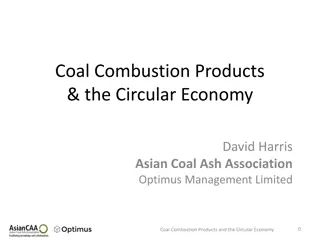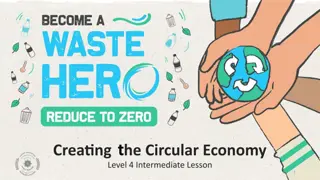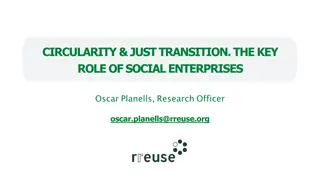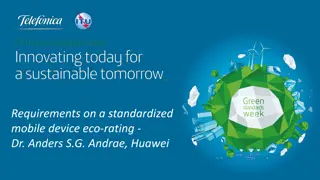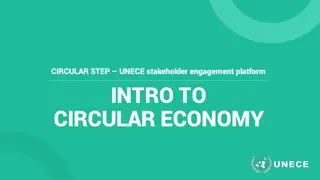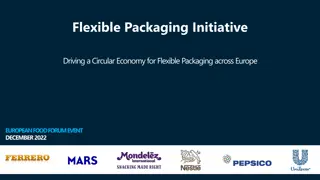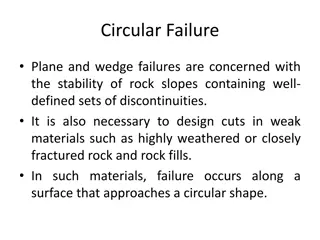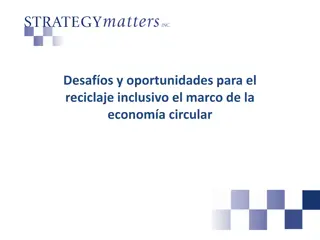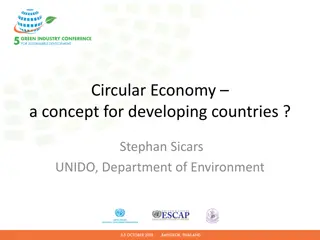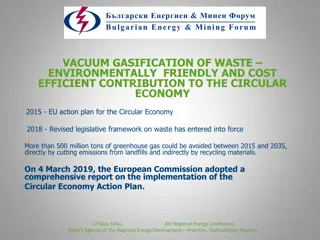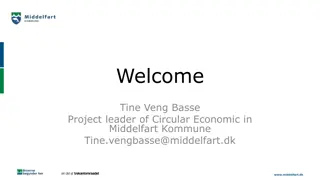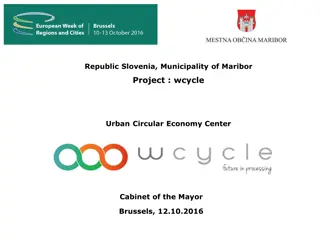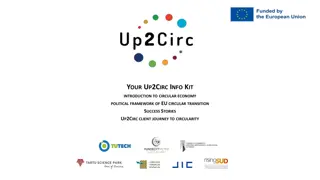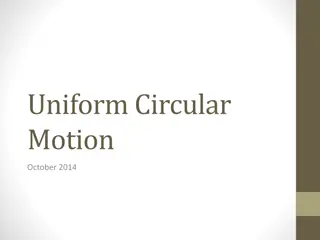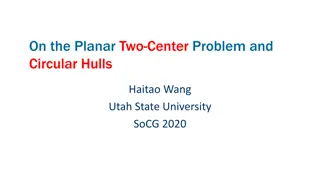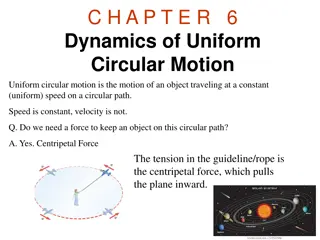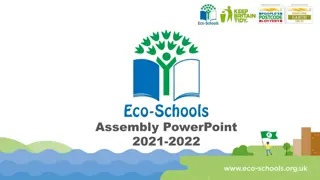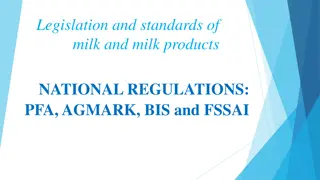Standards and Policy in Circular Economy and Eco Design: EU and India Perspectives
Explore the role of standards and policy in the circular economy and eco design from the perspectives of India and the EU, focusing on Ecodesign standardization supporting EU regulations. Learn about the Ecodesign and Energy Labelling Framework Directive, Energy Labelling Regulation, Circular Economy challenge, and how standards support sustainable products regulation.
Download Presentation

Please find below an Image/Link to download the presentation.
The content on the website is provided AS IS for your information and personal use only. It may not be sold, licensed, or shared on other websites without obtaining consent from the author. Download presentation by click this link. If you encounter any issues during the download, it is possible that the publisher has removed the file from their server.
E N D
Presentation Transcript
Circular Economy: Eco Design and Eco Labelling Role of Standards & Policy in India and the EU CEN & CENELEC perspective on Ecodesign standardization supporting EU regulations Martial PATRA Chair of Eco Design Coordination Group, CEN-CENELEC
Decoding Tomorrows Customer Demands 1. Ecodesign and Energy Labelling 2. The Circular Economy challenge 3. Ecodesign for Sustainable Products Regulation [ESPR] 4. How standards support ESPR Internal
1. Ecodesign and Energy Labelling Framework Directive Ecodesign Regulation 2009/125/EC Energy Labelling Regulation (EU) 2017/1369 Decoding Tomorrow s Customer Demands Give the EC the power to set concrete and compulsory energy efficiency requirements on energy-related products on the EU market, to decide on energy efficiency ranking of products EC standardisation requests to CEN CENELEC to develop Harmonized European Standards (hEN) on ad hoc measurement methods for each regulated product group. Specific Regulations (per product group) Requirements (thresholds, limits, minimum energy efficiency, maximum energy consumption, etc) are set in Regulations ~30 product groups Ranking based on energy efficiency Products covered by energy labelling and ecodesign requirements: dishwashers, washing machines, tumble driers, refrigerators, lamps, televisions, air conditioners, domestic cooking, appliances, heaters, water heaters, residential ventilation units, professional refrigeration, local space heaters and solid fuel boilers Products covered by efficiency requirements (and not by labelling): simple set-top boxes, external power supplies, electric motors and variable speed drives, circulators, industrial fans, water pumps, computers & servers, power transformers and air heating products Internal
2. The Circular Economy challenge Circular economy EN Standards: Tools to support the transition to a Circular Economy in Decoding Tomorrow s Customer Demands supporting EU legislation and climate targets promoting best practices optimizing installations and systems helping improving energy efficiency Internal
Better product design Circular economy Under Ecodesign Directive (2009/125/EC), Decoding Tomorrow s Customer Demands requirements focusing on reducing energy consumption and Many standards developed provide manufacturers with dedicated methods enabling them to measure the performance/energy efficiency of their products against the requirements imposed by the Regulations Legislation requesting standards to support ecodesign requirements on material efficiency aspects for energy-related products (ErP) Deliverables be general and cover the following material efficiency aspects: Extending product lifetime; Ability to re-use components or recycle materials from products at end-of-life; Use of re-used components and/or recycled materials in products 5 Internal
Better product design Circular economy Material efficiency Decoding Tomorrow s Customer Demands M/543 Ecodesign requirements on material efficiency aspects for energy- related products CEN-CENELEC/JTC 10: ErP - Material Efficiency Aspects for Ecodesign 8 standards (EN 45552 EN 45559) + a report (CLC/TR 45550:2020 ) generic principles to take into account when addressing material efficiency of products Extending product lifetime LONGER Ability to re-use components or recycle materials at end-of-life LESS Use of re-used components and/or recycled materials SMART Webinar European standards addressing material efficiency standard (here) 6 Internal
Efficient production process Better product design Circular economy Decoding Tomorrow s Customer Demands Product design and material efficiency Preserve critical raw materials (CRM: from EU list) Use of re-used components and/or recycled materials in products Extend product lifetimes Ability to re-use components or recycle materials from products at the end-of-life Internal
Collection Circular economy Recycling Material recovery (waste and secondary raw materials) Decoding Tomorrow s Customer Demands Waste characterization (CEN/TC 292) procedures to determine the characteristics of waste and wast behaviour Electronic waste (CLC/TC 111X) waste electrical and electronic equipment (WEEE) details on collection, transport and treat WEEE of specific products Packaging (CEN/TC 261) biodegradability packaging material CEN Guide 16 Guide for addressing chemicals in standards for consumer-relevant products 8 Internal
3. Ecodesign for Sustainable Products Regulation [ESPR] Make sustainable products the norm Decoding Tomorrow s Customer Demands The Sustainable Product Initiative (SPI) will revise the Ecodesign Directive and propose additional legislative measures as appropriate (like the Digital Product Passport ) Consumers, the environment and the climate will benefit from products that are more: durable, reusable, repairable, recyclable, and energy-efficient In March 2022: Proposal for a new Ecodesign for Sustainable Products Regulation, building on the Ecodesign approach' to set product-level requirements Proposal for a new strategy to make textiles more durable, repairable, reusable and recyclable Proposal for the revision of the Construction Product Regulation ESPR scope is extended to cover also non-energy related products like textiles and construction products and more. 9 Internal
4. How standards support ESPR Active support from ESO s to EC in the preparation of Standardization Requests Decoding Tomorrow s Customer Demands Identification of areas where standardization priorities should be set to foster EC in reaching its ambitious goals in time (mature solutions, quick wins, ) Identification of gaps and eventual need for R&D / Pre-Normative Research (PNR) Integration of the concept of circularityin existing and future standards Transpose experience gained in ErP sectors to non-ErP sectors Bridge between EU and non-EU actors of the standardization CEN CENELEC: ~25 technical committees and +190 standards published in the framework of Ecodesign/Ecolabeling. ESPR will increase the activity level and the number of deliverables. CEN CENELEC stands ready to deliver ! 10 Internal
Decoding Tomorrows Customer Demands Thank you for listening Internal
Better product design Circular economy CLC/TR 45550:2020 'Definitions related to material efficiency Decoding Tomorrow s Customer Demands EN 45552:2020 'General method for the assessment of the durability of energy-related products' EN 45553:2020 'General method for the assessment of the ability to remanufacture energy-related products' EN 45554:2020 'General methods for the assessment of the ability to repair, reuse and upgrade energy-related products' EN 45555:2019 'General methods for assessing the recyclability and recoverability of energy-related products' EN 45556:2019 'General method for assessing the proportion of reused components in energy-related products' EN 45557:2020 'General method for assessing the proportion of recycled material content in energy-related products' EN 45558:2019 'General method to declare the use of critical raw materials in energy-related products' EN 45559:2019 'Methods for providing information relating to material efficiency aspects of energy-related products' 12 Internal


